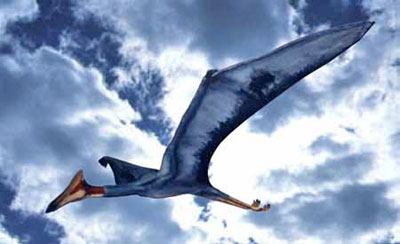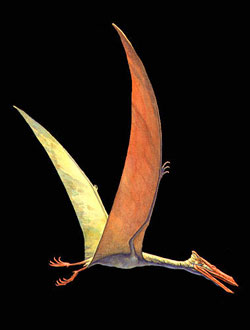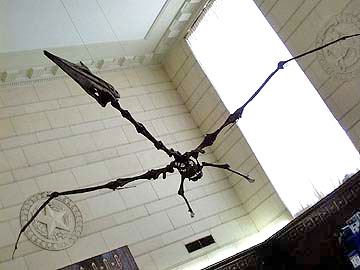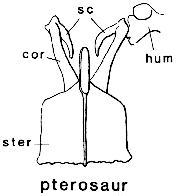|
from
PowerOfTheShaman Website
Flying reptiles have captured the popular imagination ever since Arthur Conan Doyle made them part of his science fiction story The Lost World. These great creatures have been extinct since the Mesozoic era ended 65 million years ago. Scientists named them “flying lizards” or pterosaurs (TERA sores), nearly two centuries ago, when their fossil remains were first found. How such large animals could actually fly has long been a scientific puzzle, since they weighed about as much as a human being.
Today’s hang-glider pilots must solve the problem of getting themselves airborne by using other aircraft, or leaping from great heights. How a giant lizard would take off is an unanswered question. The flying reptile was called “one of the greatest freaks of all time” by the late Harvard professor Percy Raymond. The flight mechanism was bat-like rather than bird-like.
A membrane of skin stretched from the
trunk to the front limb, but was attached to a greatly elongated
fourth finger of the hand, and not to all four fingers as with a
bat. Flying reptiles were probably soarers and gliders rather than
active flyers. They could fold their wings like bats, and may have
had similar roosting habits.
It was named after the Aztec god
who looked like a feathered serpent: Quetzalcoatlus northropi.
Pronounced “kwet zel KWAT lus,” this creature was one of the last of
the pterosaurs to survive. Its neck was extremely long, its slender
jaws were toothless, and its head was topped by a long bony crest.
Like other pterosaurs, it had fingers on the front edge of its wing
with sharp claws that could grip prey.
Perhaps it became airborne by dropping from the height of a cliff, or the crest of a wave. Or perhaps it waited until the hot sun warmed the ground and created strong thermal updrafts. Maybe it could stand up on its hind legs and catch an appropriate breeze, and with a single flap of its wings and a kick of its feet become airborne.
Once aloft, it may have stayed in the
air for long periods, riding air currents with minimal effort as it
soared slowly and gracefully over land or water looking for prey.
Its aeronautical design suggests that it could coast more slowly
than a bird, before it stalled and had to land. The great wings may
have allowed it to land gently, but its size, weight and long, weak
hind limbs suggest that it did not live in trees as birds do.
A short time later Alverico Guajardo, a resident of Brownsville, Texas, reported he'd heard a thumping noise outside his mobile home at about nine-thirty at night. When he looked out the door he saw a monstrous bird standing in his yard.
Sightings of the big bird multiplied. A
radio station offered a reward for the creature's capture. A
television station broadcast a picture of an alleged bird track. It
was some twelve inches long. The Texas Parks and Wildlife
Department, concerned that hunters might mistake a large rare and
protected bird, like a whooping crane, for this creature announced
that, "All birds are protected by state or federal law."
We may never know, because after the two month flap of sightings in 1976, reports of the big birds dwindled. The Pterosaurs, if they ever existed, have gone back into hiding.
Petroglyph found
among Native American rock art,
Above (from Padian 1985): A generalized pterosaur wing (hum= humerus, r= radius, u= ulna, mc= metacarpus, pt= pteroid, c= carpus, I-IV= numbered digits). Also pictured: A generalized pterosaur pectoral girdle (sc= scapula, cor= coracoid, hum= humerus, ster= sternum).
The pterosaur wing (shown above) was supported by an elongated fourth digit (that is, like on a hand, a "pinky finger" several feet long). Pterosaurs had other morphological adaptations for flight, such as a keeled sternum (shown above) for the attachment of flight muscles, a short and stout humerus (the first arm bone), and hollow but strong limb and skull bones.
Pterosaurs also had modified scales that were wing-supporting fibers, and that possibly formed hairlike structures to provide insulation -- bird feathers are analogous to the wing fibers of pterosaurs, and both are thought to possibly have been evolved originally for the primary purpose of thermoregulation (which implies, but does not prove, that both pterosaurs and the earliest birds were endothermic).
Pterosaurs also had a bone unique to their clade. It is called the pteroid bone, and it pointed from the pterosaur's wrist towards the shoulder, supporting part of the wing membrane. Such a novel structure is rare among vertebrates, and noteworthy; new bones are unusual structures to evolve -- evolution usually co-opts bones from old functions and structures to new functions and structures rather than "reinventing the wheel".
The wing membrane of pterosaurs most
likely did not include the hindlimbs; there is no evidence for the
existence of such a membrane, but if such a membrane were to exist,
a gliding origin for pterosaur flight would probably be more
feasible.
|







